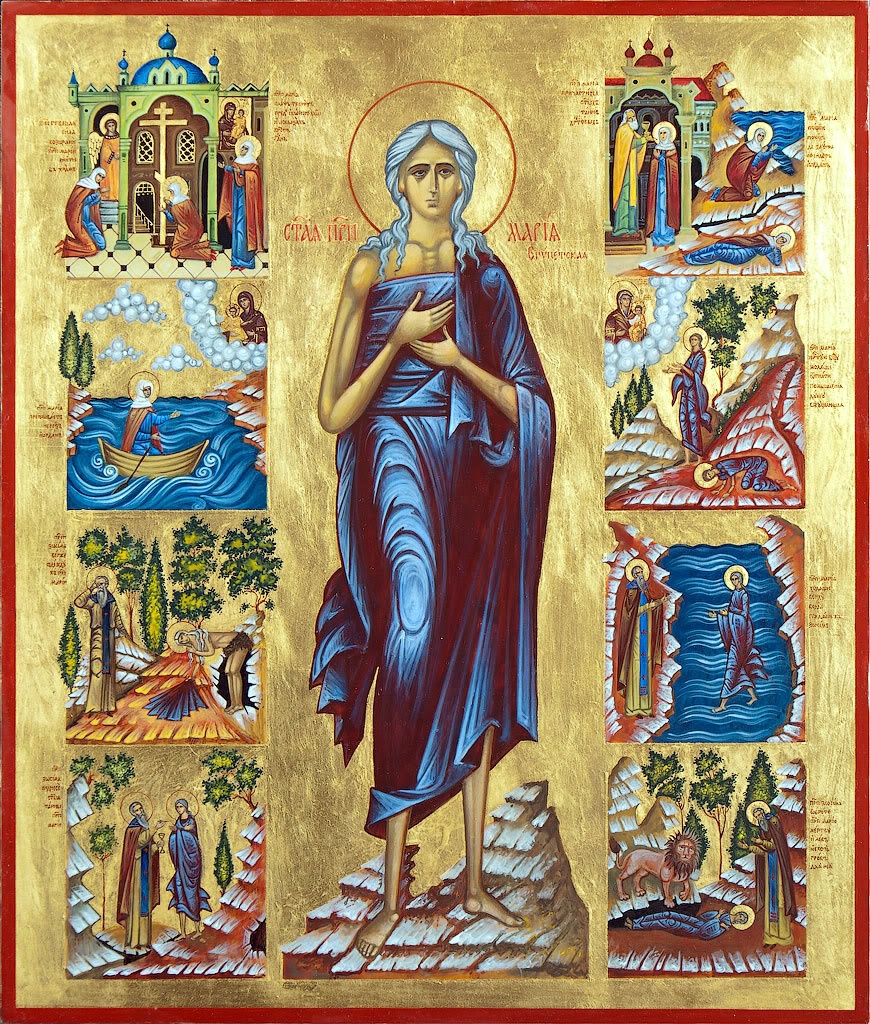
Sunday of St. Mary of Egypt, March 29, 2015
Rev. Fr. Andrew Stephen Damick
In the Name of the Father and of the Son and of the Holy Spirit, one God. Amen.
We are now almost done with our ten week series on evangelism during this holy season of the Triodion! Just today and next week left to go.
Today is the Sunday of St. Mary of Egypt, the Fifth Sunday of Lent. We focus today especially on the remarkable life of this fifth and sixth century woman, who once journeyed to Jerusalem in order to ramp up a life of lascivious pleasures—not even prostitution, mind you; she did it all for free. And she had engaged in that lifestyle for seventeen long years. What happened there is an amazing story.
Mary had gone to Jerusalem from Egypt in order to find young men with whom to commit fornication, arriving at the time of the Elevation of the Cross in September. As the many pilgrims were entering the Church of the Holy Sepulchre where the True Cross was kept, she found that she was prevented from entering by an invisible force. And when she looked upon an icon of the Virgin Mary, she realized that it was God Who was keeping her outside the church, and that it was her sinfulness that was the reason.
If you came to the Small Compline service we celebrated this past week wherein we sang the entire Great Canon of St. Andrew of Crete, you will have also heard the full version of the life of St. Mary of Egypt by St. Sophronius of Jerusalem. I won’t recount the whole thing here, but I did want to weave her story together with the first part of the Gospel reading appointed for today. Let’s hear that passage again from the tenth chapter of Mark:
“Jesus took His twelve Disciples, and began to tell them what was to happen to Him, saying, ‘Behold, we are going up to Jerusalem. And the Son of man will be delivered to the chief priests and the scribes, and they will condemn Him to death, and deliver Him to the Gentiles. And they will mock Him, and scourge Him, and spit upon Him, and kill Him; and after three days He will rise.’”
So Jesus Himself is also on a journey to Jerusalem. We now begin to turn our hearts more deeply to that story, and in the next couple of weeks, we will follow Him to Jerusalem, and everything will be just as He predicted.
His journey to Jerusalem is obviously for very different reasons than the journey of Mary of Egypt. She went there to commit sin, while Jesus went there in order to destroy the power of sin. She goes there enveloped in corruption and impurity, while He goes there incorrupt and pure. She goes there in glory and desired by all, and He goes there in humility, rejected and cast aside.
But both go there to the Cross. And both go there to die.
Yes, we know that the Lord Jesus goes there to be crucified and to die on that very cross which Mary approached. But how is Mary going there to die?
When she approaches the Cross and is prevented from coming near to it, something begins in her that she had not felt before—she begins to repent. She looks upon the face of the Mother of God, Who herself had once looked upon that same cross and wept bitter maternal tears, her soul pierced through as with a sword as she saw her Son dying on that cross. And when Mary looks upon the face of the Virgin Mary, she realizes what she has done. She realizes that she has corrupted the beautiful image of God within her, and the tears begin.
She purposes to change her way of living, and she goes into the Church of the Holy Sepulchre, that church which holds the very tomb of Christ, where He had laid dead, and she venerates the True Cross. In that moment, even though she does not physically die as He did, she partakes of His death. And so she also went to Golgotha, the “place of the skull,” as it is called, and she touched the Cross of Jesus. And she died to sin.
The journey of Mary of Egypt to the Cross parallels the journey of Jesus Christ. While He bore our sins, she brought her own sins there to be borne by Him. And while she who had lived for her flesh died to the lusts of the flesh, to sin and to death, He died so that He might condemn sin in His flesh (Rom. 8:3). And while He rose from the dead, once for all, the Firstborn from the dead (Col. 1:18, Rev. 1:5), her process of resurrection began as she was joined to Christ, and she will be resurrected to the resurrection of life at the last day (John 5:29).
How do we incorporate all this into our evangelism, our preaching of the good news of Jesus Christ?
First, we should get to know the full story of St. Mary of Egypt. It’s a stunningly beautiful narrative, especially as St. Sophronius tells it from the point of view of St. Zosimas, who meets Mary in the desert after she has spent some 47 years in repentance and is able to work rather unselfconcsious miracles like walking on water or levitating in prayer. She who had spent 17 years in great sin is able to become one of the greatest of the saints. This means that, if there was hope for her, there is hope for everyone.
But more deeply, as we preach Christ to our family, friends and co-workers, we emphasize that Christ is One Who suffered for us so that we might be released from our sins and be resurrected from the dead.
So many people have an image of God that is of some old man sitting on a throne up in the sky and judging them for everything they do. They feel that Christianity is about condemnation, that it is about moralism. But these people need to hear that the true story of Christianity is of the God Who became one of us so that He would suffer as one of us, so that in His own flesh He would destroy sin itself. He did not come into this world to condemn the world but to save it (John 3:17).
What if, when Mary of Egypt approached the Lord’s mother and began her repentance, what she received was judgment and condemnation for the way she had been living? It probably would not have been the same story.
But when she approached, she was received. She was loved. She drew near to the Cross of Jesus and knew the God-man Who had been delivered up to condemnation, to mocking, scourging, spitting and even to death itself.
And this is the Jesus Whom Mary encountered, the Jesus Whom we preach.
This also needs to be the Jesus Whom we are like. When someone comes to us who might resemble Mary of Egypt prior to her conversion—someone we might feel superior to, someone with whom we might feel we have nothing in common, someone we don’t know, someone we don’t like, someone whom we feel doesn’t belong here, someone whom we would prefer weren’t in our lives—that is the moment when we have to be most like Jesus Christ. That is the moment when we, like the Virgin Mary did for Mary of Egypt, extend the love and the hospitality and warmth of Jesus Christ to someone who is hurting, perhaps even unbeknownst to himself.
This is evangelism—that we know these stories and tell these stories, and also that we are able to become part of these stories so that others can be invited in, as well.
So as we are being equipped for this holy ministry, we ask for the prayers of St. Mary of Egypt, the Mother of our Lord, and of all the saints. Who knows? Perhaps we may introduce the next Mary of Egypt to the Church.
To our suffering and loving God, the Father and the Son and the Holy Spirit, be all glory, honor and worship, now and ever, and unto ages of ages. Amen.




Beautiful story Father and beautifully told. So inspiring to see through St. Mary that there is hope for even the worse of sinners.